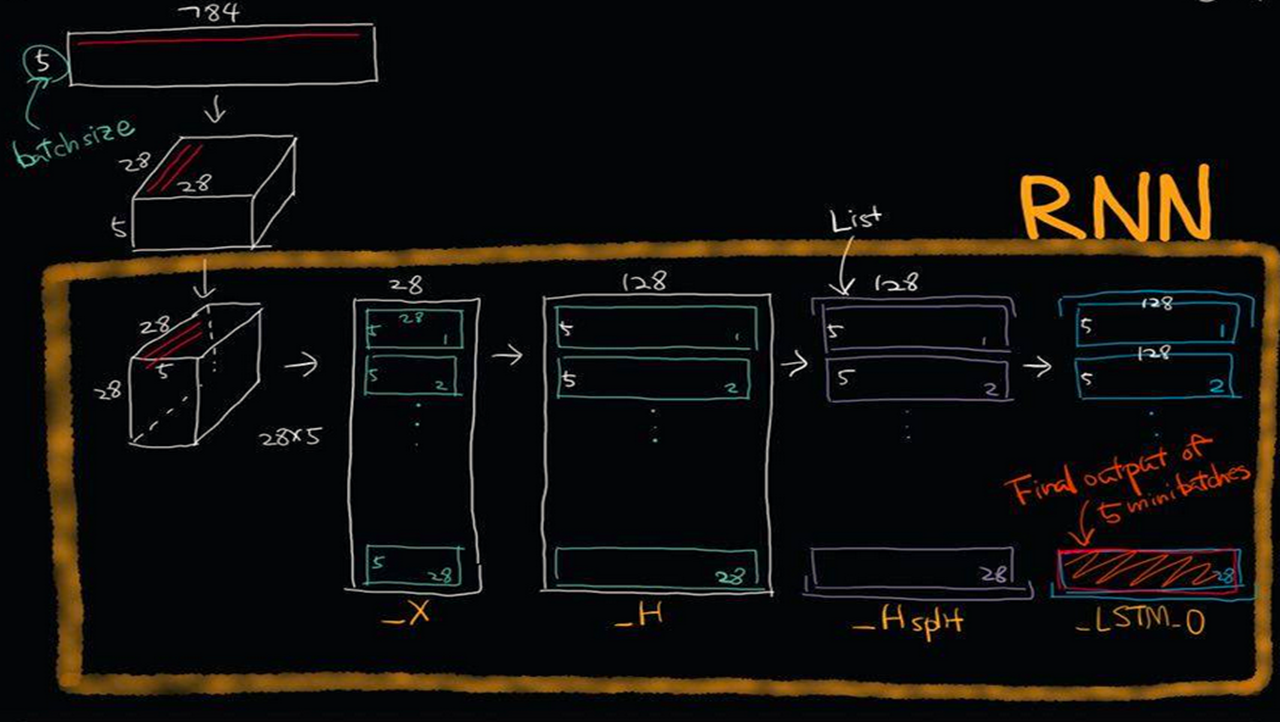循环神经网络


代码
import tensorflow as tf from tensorflow.examples.tutorials.mnist import input_data #tf.compat.v1.reset_default_graph() tf.compat.v1.disable_eager_execution() mnist = input_data.read_data_sets("./mnist_data", one_hot=True) trainimgs= mnist.train.images trainlabels = mnist.train.labels testimgs= mnist.test. images testlabels = mnist.test.labels ntrain,ntest,dim, nclasses= trainimgs.shape[0], testimgs.shape[0], trainimgs.shape[1], trainlabels.shape[1] diminput= 28 dimhidden = 128 dimoutput = nclasses nsteps= 28 weights = { 'hidden': tf.Variable(tf.compat.v1.random_normal([diminput, dimhidden])), 'out': tf.Variable(tf.compat.v1.random_normal([dimhidden,dimoutput])) } biases = { 'hidden': tf.Variable(tf.compat.v1.random_normal([dimhidden])), 'out': tf.Variable(tf.compat.v1.random_normal ([dimoutput])) } def _RNN(_X,_W,_b,_nsteps,_name): #[batchsize, nsteps,diminput] _X = tf.transpose(_X,[1,0,2]) #[nsteps*batchsize,diminput] _X = tf.reshape(_X, [-1, diminput]) _H = tf.matmul(_X, _W['hidden']) + _b['hidden'] _Hsplit = tf.split(_H,_nsteps,0) print(_name) with tf.compat.v1.variable_scope(_name, reuse=tf.compat.v1.AUTO_REUSE) as scope: #变量共享 scope.reuse_variables() lstm_cell= tf.compat.v1.nn.rnn_cell.BasicLSTMCell(dimhidden,forget_bias = 1.0) _LSTM_O, _LSTM_S = tf.compat.v1.nn.static_rnn(lstm_cell,_Hsplit, dtype = tf.float32) _O = tf.matmul(_LSTM_O[-1],_W['out']) + _b['out'] return{ 'X': _X,'H': _H, 'Hsplit': _Hsplit,'LSTM_O':_LSTM_O,'LSTM_S':_LSTM_S,'O':_O } learning_rate = 0.001 x= tf.compat.v1.placeholder(tf.float32,[None,nsteps,diminput]) y= tf.compat.v1.placeholder(tf.float32,[None,dimoutput]) myrnn =_RNN(x,weights,biases,nsteps,'basic') pred= myrnn['O'] cost = tf.reduce_mean(tf.nn. softmax_cross_entropy_with_logits (pred, y)) optm = tf.compat.v1.train.GradientDescentOptimizer(learning_rate).minimize(cost)# Adam accr = tf.reduce_mean(tf.cast(tf.equal(tf.argmax(pred,1),tf.argmax(y,1)),tf.float32)) init=tf.compat.v1.global_variables_initializer() with tf.compat.v1.Session() as sess: # 初始化变量 sess.run(init) # 开始训练 for i in range(100): # 获取真实值 batch_xs,batch_ys = mnist.train.next_batch(16) batch_xs=batch_xs.reshape((16,nsteps,diminput)) # print(image.shape) # print(label.shape) _, loss_value, accuracy_value = sess.run([optm, cost, accr], feed_dict={x: batch_xs, y: batch_ys}) print("第%d次的损失为%f,准确率为%f" % (i + 1, loss_value, accuracy_value))